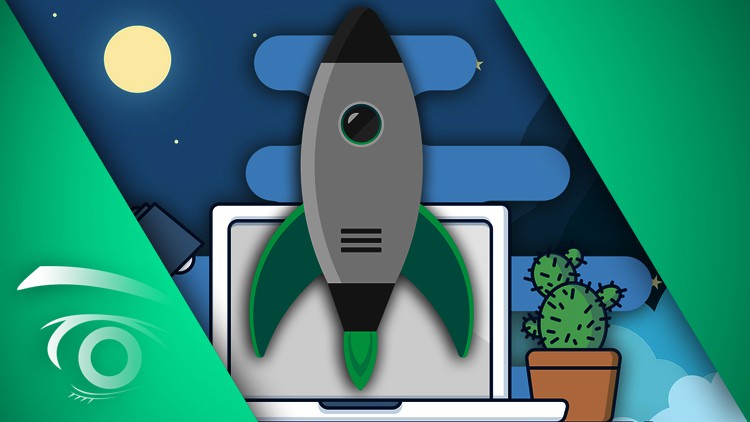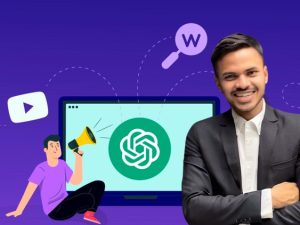Web Development Masterclass - Online Certification Course
- Description
- Curriculum
- FAQ
- Reviews
This course offers a comprehensive look into the entire web development process – from local server configuration using WAMP and MAMP (Apache, MySQL, PHP) to production deployment using the latest web technologies including: LAMP Stack (Linux, Apache, PHP and MySQL) for Ubuntu, HTML5, CSS, Bootstrap, JavaScript, jQuery, XML, and AJAX.
The content is ideal for those interested in working as a web developer, launching a web application, or devoted enthusiasts. The concepts explored in this course are suitable for individuals of all skill levels. Each module starts with the fundamental concepts and gradually transitions into more advanced material.
What makes this course unique?
This course is specifically intended to teach students to develop web applications using the most efficient methods and the latest web technologies. Through live demonstrations we teach the importance of using scalable cloud hosting infrastructures during the development process. This includes small informational websites of only a few pages to advanced ‘big data’ style, dynamic web applications. We go through several live examples of web development and Linux based server configurations on popular Cloud hosting providers such as Linode.
Section 1 & 2 (Introduction, How the Internet Works)
The course begins with with an overview of learning objectives. We then explore how the internet works, including the composition and transmission of data packets over both local and wide-area Networks. Next we take a look at the HTTP and HTTPS protocols as applicable to client and server side communications – including DNS Lookups. This section will also teach students how email exchange works over SMTP and IMAP. The role of Network Ports and Firewalls are also introduced.
Section 3, 4: (The Web Development Process, Planning a Website)
Students will gain an understanding of all the steps involved in the web development process.
Section 5: Web Hosting and System Requirements
We conduct an in-depth case analysis of web hosting solutions including: Shared, Virtual Private, Dedicated and Cloud Hosting.
We provide an overview of various packages offered by different web hosting companies and weigh the pros and cons of each one.
Students are also introduced to the importance of web server scalability and the advantages of cloud hosting over traditional hosting services. We also examine the infrastructure requirements of popular, resource intensive applications such as Netflix and Facebook to emphasize the importance of avoiding costly mistakes in the initial stages of development.
Section 6: Domain Names
We provide an overview of the domain name registration process. This includes the role of registrars and TLD (Top Level Domain) administration by ICANN. ccTLD’s (Country Code Top Level Domains) are also explored.
Students gain hands-on experience with the registration process using popular domain registrars. We provide a comparison of different registrars and register a sample domain name using GoDaddy. Other topics of discussion include: domain name privacy and administration, auto-renewal, domain forwarding, and name server assignment.
Section 7: Testing Environment
Students are introduced to configuring a local testing server on a PC or MAC system using WAMP (Windows) or MAMP (MAC). The lessons provide a detailed guide on installation of the packages and an overview of the interface.
Section 8: Production Environment
Students acquire the skills needed to optimally configure a live production environment for securely hosting web applications on a cloud server (Linode). The section starts with an overview of different cloud hosting providers such as Amazon Web Services, Microsoft Azure, Linode and Digital Ocean.
We then provide a live demonstration of server setup using Linode. This includes deployment of Ubuntu and installation of LAMP Stack (Linux) on the Linode Server using remote access consoles such as Terminal (MAC) and PuTTY for Windows.
Students gain an in-depth knowledge of server maintenance, file and directory commands. We also explore SSH Authentication for multiple users and file permissions to reduce security vulnerabilities. Remote Desktop connections for server administration are taught, using Tight VNC (Windows) and RealVNC (MAC).
A thorough overview of the Linode server management console is conducted, to show students how to scale servers, change root passwords, manage the DNS Zone file and create back-ups.
Section 9: FTP Setup
Students learn the role of an FTP (File Transfer Protocol) client to connect to a remote server, through a local machine. We provide a live demonstration on file upload using FileZilla and explore the FileZilla Interface for connection management.
Section 10: HTML Development
This section explores HTML. HTML is a key fundamental building block when learning to develop websites. Students initially learn the basics of HTML page structure and gradually transition into working with spacing, text formatting, lists, images, videos, links, anchors, tables, forms and much more. We include several projects, where students are shown first-hand, how to develop and code html web pages from scratch.
Section 11: CSS Development
Students learn to use CSS to create stylish, responsive web page layouts. We start by discussing the parts and types of CSS rules, followed by CSS classes, DIVS, and ID’s. Students gain significant exposure to various formatting options, including margins, padding, font properties, backgrounds, transparency, positioning, link styling and CSS tables. This section includes a hands-on web development project where students utilize the concepts explored in the lesson.
Section 12: Document Object Model (DOM)
As a precursor to JavaScript, we explore the DOM (Document Object Model). We explain its usage and application in manipulating HTML and CSS elements.
Section 13: JavaScript Development
We introduce students to JavaScript coding to add interactivity to static HTML and CSS pages. The section starts with discussing JavaScript placement, using both internal and external scripts. We then take a look at JavaScript output, variable declarations, arithmetic operators, objects, strings, math functions, arrays, conditional statements, loops, functions and events. Students also go through two hands-on projects that will further solidify their knowledge of the concepts explored in the lessons.
Section 14: JQuery Library
We explore the jQuery library and many of its unique features, used to create stunning, animated web pages. We start with the basics, from embedding jQuery into web pages to working with Selectors. Students then explore working with events, toggling, fading, sliding, and other forms of animation. The lessons also teach students how to work with callbacks, chaining, dragables, accordion menus and many other functions.
Section 15: Bootstrap Framework
Students are taught to use the Bootstrap framework for responsive, mobile-first – front-end development. As one of the leading open-source development libraries, Bootstrap is an essential part of the developers coding arsenal. The section begins with teaching students how to include essential Bootstrap files into web pages. It then explores the Bootstrap Grid system and popular layout strategies for optimal cross-device and cross-browser compatibility.
Students gain exposure to just about every Bootstrap component, from typography, tables and images, to jumbotrons, wells, alerts, buttons, glyphicons and progress bars. The section includes several hands-on exercises that will walk students through the process of creating stunning layouts, complete with modals, carousels, popovers, drop-down menus, forms and much more.
Section 16: PHP Development
Students gain exposure to creating dynamic web applications and functionality using PHP. We start with the basics, including variable declaration and data output. The lessons then transition into working with objects, conditional statements, loops, functions, arrays and form validation.
Section 17: MySQL Database Integration
Students learn to unleash the true power of web application development with MySQL database integration. We start with the basics from database and table creation, to user management. Next we explore the execution of commonly used SQL statements for database modification and administration. Students are also taught how to create database connections and execute SQL statements from PHP scripts.
Section 18, 19 (XML, AJAX, & Development)
We explore XML and AJAX integration to create dynamic content, without page refresh. The lessons cover several hands-on training exercises that will encompass many of the exciting functions AJAX offers. Students will build a website complete with database integration, registration forms with server-side validation, user authentication, and a SMTP-based contact submit form.
Section 20: Google Apps for Work
Students learn to create a customized business email address using Google Apps for Work. Email administration is also explored, along with alias creation.
-
2The Internet OverviewVideo lesson
Students will learn key terms that are instrumental in web development, including:
- Data Packet Transmission
- Data Packet header, payload and trailer
- Internet bandwidth, bit-rate and latency
- Protocols, IP & TCP
-
3The HTTP ProtocolVideo lesson
Students learn how web page data is delivered using HTTP (Hyper Text Transfer Protocol) and GET Requests. DNS (Domain Name Servers) are also introduced.
-
4The HTTPS ProtocolVideo lesson
Students are introduced to HTTPS (Hyper Text Transfer Protocol Secure). We explore several components of this protocol including:
- SSL (Secure Socket Layer)
- TLS (Transport Layer Security)
- SSL Handshake
- EV (Extended Validation Certificate)
-
5The SMTP Protocol and Local Mail DeliveryVideo lesson
Students learn the flow of email exchange using SMTP (Simple Mail Transfer Protocol).
We also explore POP3 & IMAP for Local Mail Delivery. -
6Outbound Mail DeliveryVideo lesson
This lecture expands on our discussion on email exchange, with a focus on outbound mail delivery.
-
7Network Basics - LAN and WANVideo lesson
Students are introduced to the basics of an internet and local network. We discuss both Local and Wide Area Networks (LAN, WAN).
-
8Network Ports and FirewallsVideo lesson
Students are introduced to key terms relevant to data packet exchange over local and wide area networks, including:
- Routers
- Network Ports
- Hardware and Software Firewalls
- Data Pipelines
- Internet Service Provider (ISP)
-
12Web Hosting Packages OverviewVideo lesson
This lecture provides an introduction on the different types of web hosting solutions that the course will explore, including:
- Shared Hosting
- Virtual Private Servers (VPS)
- Dedicated Servers
- Virtual Cloud Servers
-
13Shared HostingVideo lesson
This lecture focuses on shared hosting solutions and offers a comparison of several packages available through popular hosting providers.
Several Key terms are explored including:- Bandwidth
- Cloaking
- Disk Space
- Linux vs. Windows Operating Systems
- Scripting language compatibility
-
14Dedicated HostingVideo lesson
This lecture discusses dedicated hosting solutions and provides a detailed comparison of different packages.
-
15VPS HostingVideo lesson
This lecture discusses Virtual Private Servers (VPS) and provides a detailed comparison of different packages.
-
16Cloud Hosting and Case StudyVideo lesson
This lecture provides a detailed overview of Cloud hosting and defines the "computing cloud".
We present a case study comparing cloud hosting to traditional hosting solutions in creating basic and "big data" style websites and applications.
Students will learn the concepts of flexibility, scalability, cost efficiency and reliability as applicable to virtual cloud servers.
We also explore various cloud hosting packages offered by popular providers such as Linode.
-
17Introduction to Domain NamesVideo lesson
Students learn key terminology as applicable to domain names and registration, including:
- Registries
- Registrars
- Top Level Domains
- ICANN (Internet Corporation for Assigned Names and Numbers)
- ccTLD (Country Code Top Level Domain).
- IP to Domain Name Resolution.
-
18Domain Name RegistrarsVideo lesson
This lecture discusses the importance of selecting the right domain registrar for registration.
We explore essential terms such as: Domain Brand Protection, Domain Monitoring, Enforcement, Security and Trademarking. -
19Domain RegistrationVideo lesson
In this lecture we register a sample domain using registrar GoDaddy.com.
-
20Registration and Privacy ProtectionVideo lesson
This lecture is a continuation of domain name registration. We demonstrate how to enable domain privacy to protect against the publication of personal information on public WHOIS records.
-
21Control Panel Sign-InVideo lesson
This lecture demonstrates how to log in to the GoDaddy domain management console.
Students will learn to administer the Domain DNS settings and configure Auto Renewal.
-
22Auto-Renewal and Domain LockVideo lesson
This lecture further explores the GoDaddy domain management system, including the domain lock and domain transfer authorization.
-
23Domain ForwardingVideo lesson
Students learn the difference between permanent and temporary domain redirection. We also explore domain and sub-domain forwarding.
-
24NameserversVideo lesson
In this lecture we define the role of Name-servers (NS Records).
Students are also introduced to A-Records and MX-Records.
-
25Update Registration InformationVideo lesson
Students learn to amend Domain Registrant, Administrative, Technical and Billing information on their GoDaddy account.
-
26Quiz 2Quiz
This Quiz includes materials from Section 5-6 Inclusive.
-
27Introduction to Testing ServersVideo lesson
This lecture provides an introduction into testing servers to host web applications on a local system.
Students learn the difference between client and server-side scripting languages.
We also introduce WAMP and MAMP (Apache, MySQL, PHP) for Windows and MAC respectively.
-
28Installing WampServer - WAMPVideo lesson
Students learn to download and configure WAMP Server for Windows.
-
29Installing MampServer - MAMPVideo lesson
Students learn to download and configure MAMP Server for MAC.
-
30WampServer MenuVideo lesson
This lesson explores the WAMP menu including:
- Starting and Stopping the WAMP Service
- Storing files into the Web Root (www) Folder.
- Exploring important configuration files for PHP, MySQL and APACHE.
-
31Localhost File TestVideo lesson
Students learn to test their WAMP configuration to make sure all services are working properly.
-
40Linode Account SetupVideo lesson
-
41Exploring the Linode Cloud ManagerVideo lesson
-
42Enabling TFA on LinodeVideo lesson
-
43Deploying a Linode Virtual InstanceVideo lesson
-
44Exploring the Linode Instance DashboardVideo lesson
-
45Remote Server Admin via SSHVideo lesson
-
46Password vs SSH Key AuthenticationVideo lesson
-
47SSH Key Pair Authentication on WindowsVideo lesson
-
48SSH Key Pair Authentication on MacOSVideo lesson
-
49Connecting with LISHVideo lesson
-
50Adding SSH Public Keys to LinodeVideo lesson
-
51Introduction to LinuxVideo lesson
-
52The Linux FilesystemVideo lesson
-
53Linux Maintenance CommandsVideo lesson
-
54Linux Directory Commands [Part 1]Video lesson
-
55Linux Directory Commands [Part 2]Video lesson
-
56Ubuntu Basic Server ConfigurationVideo lesson
-
57Introduction to User AccountsVideo lesson
-
58Creating a Non-Root AccountVideo lesson
-
59Securing the New User AccountVideo lesson
-
60Disabling Root User Access and Password AuthenticationVideo lesson
-
61Introduction to Web ServersVideo lesson
-
62Self Hosting vs Hosting ProviderVideo lesson
-
63Web Server Software (NGINX vs Apache)Video lesson
-
64Introduction to DatabasesVideo lesson
-
65SQL vs NoSQL DatabasesVideo lesson
-
66Database Transaction Standards (ACID vs CAP)Video lesson
-
67CAP Theorem for NoSQL DatabasesVideo lesson
-
68Characteristics of SQL vs NoSQL DBMSesVideo lesson
-
69Key Terms: Stacks, Frameworks, & Languages [Part 1]Video lesson
-
70Key Terms: Stacks, Frameworks, & Languages [Part 2]Video lesson
-
71Key Terms: Stacks, Frameworks, & Languages [Part 3]Video lesson
-
72Installing LAMP Stack on Ubuntu via Command LineVideo lesson
-
73Installing LAMP Stack using Linode MarketplaceVideo lesson
-
74Testing PHP on ApacheVideo lesson
-
75Testing MariaDB Connection from PHP [Part 1]Video lesson
-
76Testing MariaDB Connection from PHP [Part 2]Video lesson
-
77Remote Server Administration using Linode GLISHVideo lesson

External Links May Contain Affiliate Links read more





